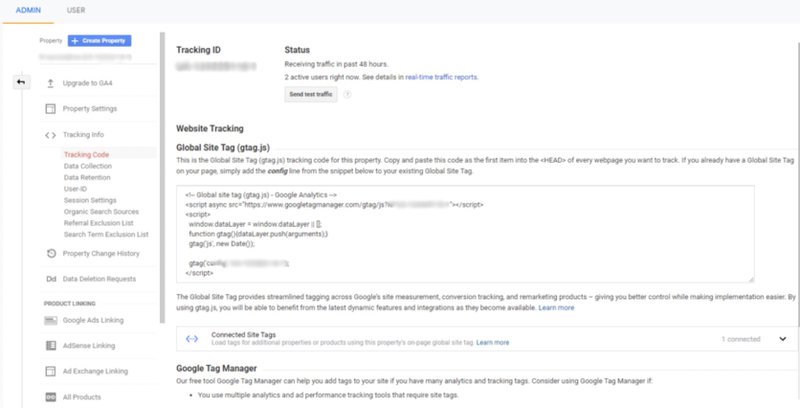如果您已经使用 Google Analytics 一段时间,您可能已经听说该平台正在发生变化。Universal Analytics 在 2023 年之后将不再处理数据,客户将需要迁移到 Google Analytics 4 媒体资源。幸运的是,我们创建了一个指南来帮助您进行这一转变。
在本文中,我们将更详细地介绍 Google Analytics 4 及其新功能。然后,我们将解答一些常见的 GA4 问题。让我们开始这场盛宴吧!
Google Analytics 4 到底是什么?
您可能知道,Google Analytics 是一款可以跟踪和衡量您网站流量和性能的分析工具。另一方面,Google Analytics 4 (GA4) 是一款提供各种报告的新功能。
Google Analytics 3(也称为Universal Analytics)将于2023年7月1日停止处理数据。要继续跟踪您网站的效果,您必须升级到Google Analytics 4。
实际上,您可能已经注意到 Google Analytics 信息中心上有一条横幅,鼓励您切换到 GA4 媒体资源:

Google Analytics 4 旨在帮助组织测量多种数据类型,同时满足日益增长的用户隐私需求。它允许网站所有者查看其所有网站和应用上的用户旅程。
GA4 还使用机器学习技术来预测新发现。在下一部分中,我们将更深入地探讨其中的一些方面。
Google Analytics 4 的新功能
Google Analytics 4 将帮助您更有效地跟踪目标。这些目标可能包括提高销售额、安装应用程序或创造潜在客户。
让我们来看看 GA4 最重要的方面!
1. 机器学习带来更智能的营销洞察:
Google Analytics 4 融合了 Google 强大的机器学习功能,可以自动查找数据趋势并提醒您。Google 一直是机器学习领域的领导者,因此这一改进并不令人意外,但它确实强大且实用。
Google Analytics 4 可以预测用户的行为和动作,让您提前规划。谷歌表示,它将继续纳入预测指标。例如,GA4 可以预测您从某个群体获得的收入。这些新功能将使您能够开发受众并进行分析,以确定为什么一组客户比另一组客户更有可能转化。
2.改进Google Ads集成:
Google Analytics 4 还与 Google Ads 更紧密地集成。您可以利用 GA4 数据来创建独特的受众群体,无论您的消费者如何与您的公司互动,这些受众群体都与您的消费者更相关且更有益。
谷歌还推出了跟踪 YouTube 转化的选项,声称该选项“满足了长期以来广告商的需求”。
3.以客户为中心的指标和对客户生命周期的更好理解:
在我看来,这些是这次升级的重大改变。GA4 不再监控按设备或平台划分的数据,而是采用以客户为中心的指标,让营销人员能够了解客户如何与其网站互动。
据谷歌称,GA4 采用了多种身份空间,包括营销人员提供的用户 ID 和选择广告个性化的用户的谷歌信号。
这为营销人员提供了买家旅程的完整画面。假设客户从您的应用或网站购买了任何商品。您将能够了解客户在购买之前所采取的步骤,例如在 YouTube 上看到您的广告,从而引导他们访问您的网站或下载您的应用。
GA4 还让营销人员更好地了解消费者的生命周期。从他们首次访问您的网站到他们进行购买。这对于吸引和留住新客户至关重要。
Google 重新组织了报告,以便您可以根据您的目标获得营销见解,例如客户在完成购买之前如何与您的网站互动。
所有这些都为我们作为营销人员提供了详细的数据,使我们能够成功地规划我们的活动并做出决策,特别是在用户行为和需求快速变化的时代。
4.新的数据管理选项:
谷歌采用了一种新方法来 数据控制,数据隐私是该行业的主要关注点。它具有三个独特的特点:(1)GA4 用户可以选择如何收集、保留和共享其数据;(2)GA4 用户可以选择是否将获取的数据用于广告个性化;(3)GA4 用户可以通过向 Google 发出请求来删除 Analytics 数据。
谷歌表示,GA4 旨在适应没有 Cookie 和标识符的未来。谷歌打算填补 数据差距 使用机器学习,以便营销人员可以继续使用正确的数据并根据数据驱动的信号调整他们的广告。
5. 反垃圾邮件措施:
如果您已经使用 Google Analytics 一段时间,那么您可能听说过垃圾邮件推荐。也许您经历过流量的短暂激增,或者收到大量来自未知来源的点击。
这种垃圾流量可能会扰乱您的营销活动,使可靠的数据收集变得困难。幸运的是,Google Analytics 4 已经找到了解决此问题的方法。
以前,垃圾邮件发送者可以使用 测量协议 向 Google Analytics 帐户提供虚假数据。现在只有使用密钥的匹配才能将数据发送到 GA4 媒体资源。此密钥可通过您的 GA4 数据流设置访问,并且不公开。
有必要升级到GA4吗?
本质上是的。2023 年 7 月 1 日,Universal Analytics 将停止数据处理。因此,为了继续跟踪您的表现,您必须升级到 GA4。您不需要这样做,但 2023 年 7 月 1 日之后您将没有数据。
我们鼓励您尽快完成此操作。这样,您将有足够的时间熟悉用户界面及其令人印象深刻的功能。
此外,GA4 优先考虑用户隐私,并包含广泛的数据收集和使用选项。它也不会保存 IP 地址。因此,升级到 GA4 可以帮助您满足国际数据保护标准。
如果您已在使用 Universal Analytics,则可以将 Google Analytics 4 添加到现有帐号。GA4 将使用您当前的帐号收集数据,直到 2023 年逐步停用为止。
配置 Google Analytics 4
现在您已经熟悉了新功能,让我们开始使用您的新 Google Analytics 4 帐户。
对于现有的 Google Analytics 媒体资源,请导航至“管理”,然后在“媒体资源”下找到“升级到 GA4”按钮。在“我需要创建新的 Google Analytics 4 媒体资源”下,点击“开始”。

如果您已经在网站上使用 gtag.js 标签,则可以通过修改现有标签来启用数据收集。这样就无需向您的网站添加新的跟踪代码。在使用此选项之前,我强烈建议您阅读有关 使用相关网站标签时的注意事项.
我正在使用 Google Tag Manager 实现我的标签,因此我只是使用我的财产的 UA ID,而不是 gtag.js。
点击“继续”后,您将进入新 GA4 帐户的属性设置。
如果您仍在网站上使用旧的 Google Analytics 属性,请转到“跟踪信息”,然后转到“跟踪代码”。如果您在“关联网站标签”下注意到新的 GA4 测量 ID,则表示您可以继续。

如果您希望安装新的跟踪标签,请转到管理员,选择您建立的新 GA4 属性,然后选择“设置助手”,再选择“标签安装”。您将被发送到“数据流”菜单。在这里您可以告诉 Google 您的数据来自哪里。您的网站应该在那里;点击它以查看您的测量 ID 和新的 gtag.js 跟踪代码,您现在可以在您的网站上安装它。

如果您使用的是 Google Tag Manager,请登录您的帐户,创建新标签,然后选择“Google Analytics:GA4 配置”。从“数据流”部分复制并粘贴您的测量 ID。将触发器设置为“所有页面”,然后提交您的标签并保存您的修改。

这只是基本设置。这只是为了确保您的新 GA4 媒体资源能够跟踪您网站上的流量。如果您想深入了解,只需转到管理,点击“设置助手”,然后您就会看到链接 Google Ads 帐户的位置、设置用户 ID、定义受众等等。

结论
2023 年 7 月,Google Analytics 4 (GA4) 将取代 Universal Analytics (UA)。新版本为营销人员和企业主提供了更强大的功能,同时强调用户隐私。
如前所述,GA4 结合了人工智能驱动的洞察和预测,以帮助改善您的营销计划。此外,它还可以对数据收集和消费进行精细控制,并防止虚假流量。通过以下方式联系我们 在线聊天 如果您需要有关 GA4 迁移和配置服务的任何帮助。


















